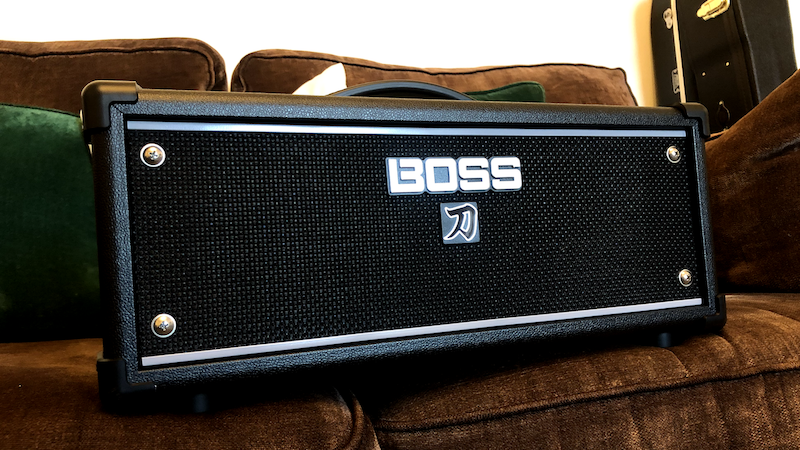Guitar World Verdict
Building on everything we love about the Generation 3 Katana combos – loads of effects, versatile amp voices, and USB-recording capabilities – the new Katana Head raises the bar. It offers gigging guitarists a highly-practical option for live performances, while the built-in 5-inch speaker makes it perfect for home practice. With its impressive features and reasonable price point, Boss has delivered an amplifier that truly does it all.
Pros
- +
Covers both home practice and gigs
- +
Tone editing capabilities from your smartphone
- +
Bloom function sounds fantastic and responsive
- +
Pushed amp type sounds great
Cons
- -
Footswitch and Bluetooth are an optional, paid-for extra
You can trust Guitar World
It’s remarkable that the Katana is fast approaching its tenth birthday. Initially released in 2016, Boss’s now-famous solid-state amp has become the best-selling amplifier range on the market. From the recently discontinued pocket-sized Katana:GO to the upscale Artist model, the range caters to a wide variety of needs. Its long reign at the top is no surprise, but it does make me feel a little old…
Versatility has always been a hallmark of the Katana range. Whether you’re after a home practice tool with deep tone editing capabilities, a plethora of amp voices, a tonne of industry-standard effects or an amp with USB recording capabilities. There’s no denying that for home use, practice, and even recording, the Katana rules all.
But what about gigging musicians who need one amp that can handle both the demands of the stage and serve as a useful practice tool for home? In decades past, that might have been a tough ask – but not anymore, thanks to the Katana Head.
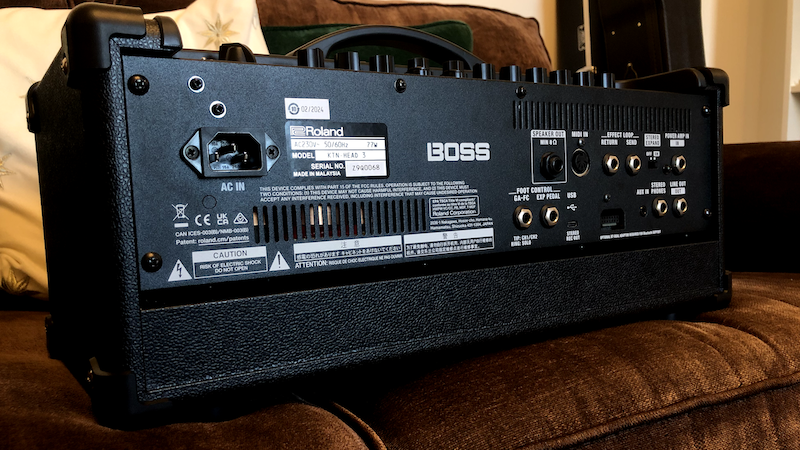
The Katana range is now in its third generation, with an entire range of updated amps released early in 2024. While the Katana Head has been a staple in the Boss lineup since 2016, advances in technology and the incorporation of features from the flagship Artist model have given the Katana Gen 3 Head some fantastic upgrades. With plenty of new bells and whistles added since the original, it continues to impress.
Sitting near the top end of the Katana range’s price point, the Gen 3 Head will set you back around $/£430. Given the extensive features and versatility it offers, I think this is a reasonable ask for what’s on offer.
Although amp heads are typically seen as heavy, single-purpose bits of kit, the Katana Head breaks from that stereotype. As players know, balancing power with home usability can be a headache. Practice amps are usually unsuitable for anything beyond bedroom use, while gigging gear is often far too loud for home practice. I can certainly relate – my dusty AC30 is patiently waiting for the next gig, not seeing the light of day in my city-center apartment.
With that in mind, I put the Katana Head Gen 3 through its paces, cranking it up in a practice room next to a drum kit in a full band setting and dialing it down for home practice, too. I’ve tested its true versatility every step of the way. Let’s take a look.
Amplifier layout
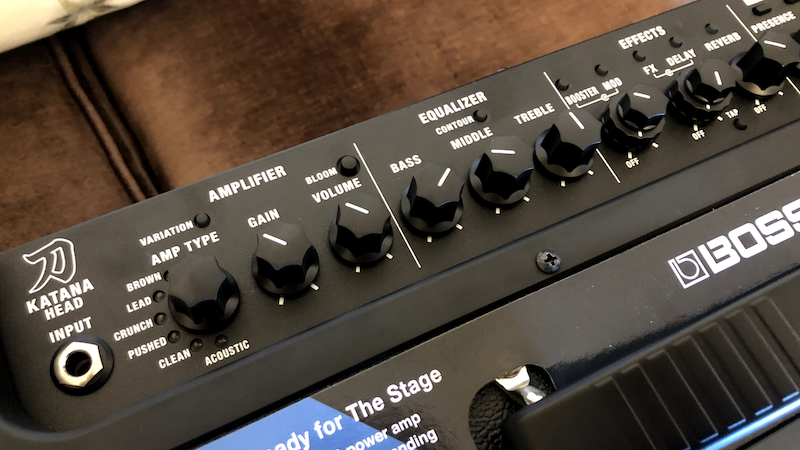
Starting with the control panel, I’m greeted by the familiar Katana layout. On the left, there’s a knob for selecting from six amp types – Brown, Lead, Crunch, Pushed, Clean and Acoustic – each with a variation, bringing the total to 12 options. You’ll also find separate gain and volume controls. Above these is the all-new Bloom function, which can be toggled on or off.
Next, is the 3-band EQ section – Treble, Middle and Bass. The Gen 3 series also introduces a new feature here: Contour. This provides three midrange contour settings, each with its own voicing, controlled by a color-coded button to indicate which one is active.
After the EQ section, you’ll encounter what I think is one of the Katana range’s standout features: controls for five built-in Boss effects – Booster, Mod, FX, Delay and Reverb – each offering three variations, for a total of 15 impressive effects. Beyond this, there’s a presence control, master volume, Solo control, a power attenuator with four modes, and a cab resonance switch offering three options: Vintage, Modern and Deep.
On the back panel, connectivity options cover everything from gigging to home recording. There’s a ¼-inch speaker out for connecting to cabinets (minimum 8 ohms), foot control and expression pedal inputs for more flexible control, and a USB-C stereo recording out, which also connects to the Boss Tone Studio for deep sound editing. You’ll also find an effects loop for keeping reverb or delay effects clean, a 3.5mm aux-in, and a ¼-inch stereo ‘phones output.
Rounding out the back panel, there’s also a ¼-inch Power Amp input that bypasses the preamp for use with a modeler. Lastly, the line out and Stereo Expand feature lets you hook up two Gen 3 Katana amps for stereo output, adding even more versatility to the rig.
Internally, behind the dark grille, lies the Katana Head’s secret weapon – a 5-inch speaker designed for home practice. While not a new addition to the Gen 3 range, this internal speaker transforms the 100-watt amplifier head into a practical desktop practice amp for home use.
Feel & sound
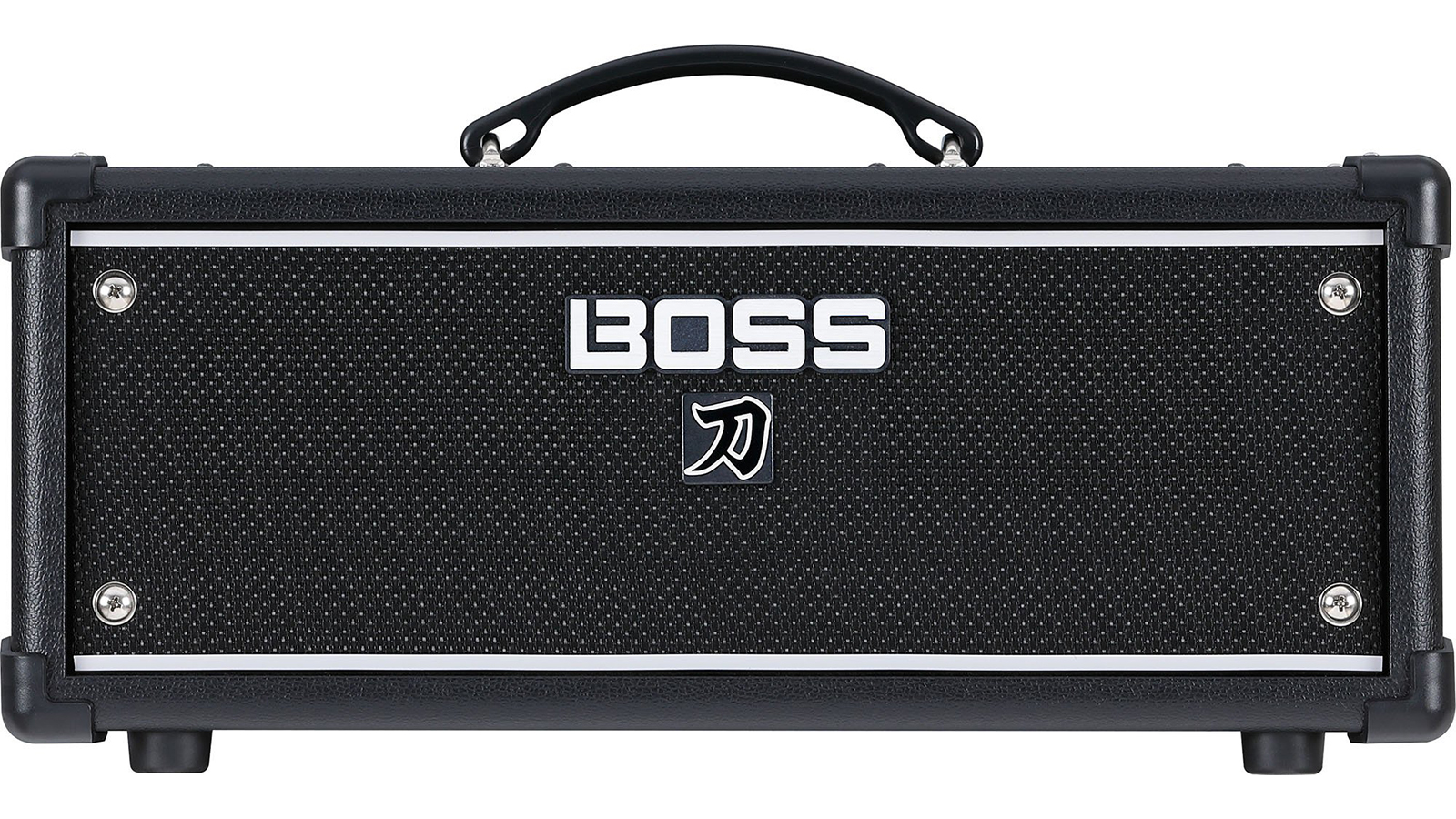
Straight off the bat and without editing via the Boss Tone Studio, the Katana Head sounds massive. Plugging it into my custom 12-inch Celestion G12H cabinet, it’s clear the six amp types cover a huge breadth of playable genres. On top of that, the Head’s volume took me by surprise; this thing is loud! It had no issue keeping up with my drummer when taking it to practice.
The brand-new Pushed amp type is perhaps the most enjoyable to play. Designed to replicate that sought-after edge-of-break-up chime produced by tubes, it is impressively dynamic. I’m currently running The Creamery’s Wide-Range humbuckers, and with the Pushed voicing it added just the right amount of grit to a clean tone, cutting through a mix perfectly and adding plenty of life.
Moreover, the new Bloom function – borrowed from the Artist model – delivers a more three-dimensional sound, with deeper lows and a noticeable boost in presence. When paired with my Nashville Telecaster’s single coils, it added a beautiful glassiness that really stood out. In my opinion, the Bloom function shines best with cleaner or slightly grittier tones, making it a perfect companion to the new Pushed amp voice.
The Contour control is another standout addition, offering even more shades to your sound. In my testing, I noticed a boosted lower-mid tone, a scooped midrange setting, and a sharper mid-focused sound that works brilliantly with the Brown amp type. All three are highly usable and will bring out different nuances depending on your pickups, pedals and guitar.
Another great feature is the Head’s internal speaker for home practice. While it won’t blow you away – it’s a 5-inch speaker with a pronounced midrange – it’s more than sufficient for practice. Just don’t push the Brown channel too hard at full power, as it may start to struggle. But for those arena-filling volumes, plugging into a cabinet is always an option. For home use, though, it does the job nicely.
Key features
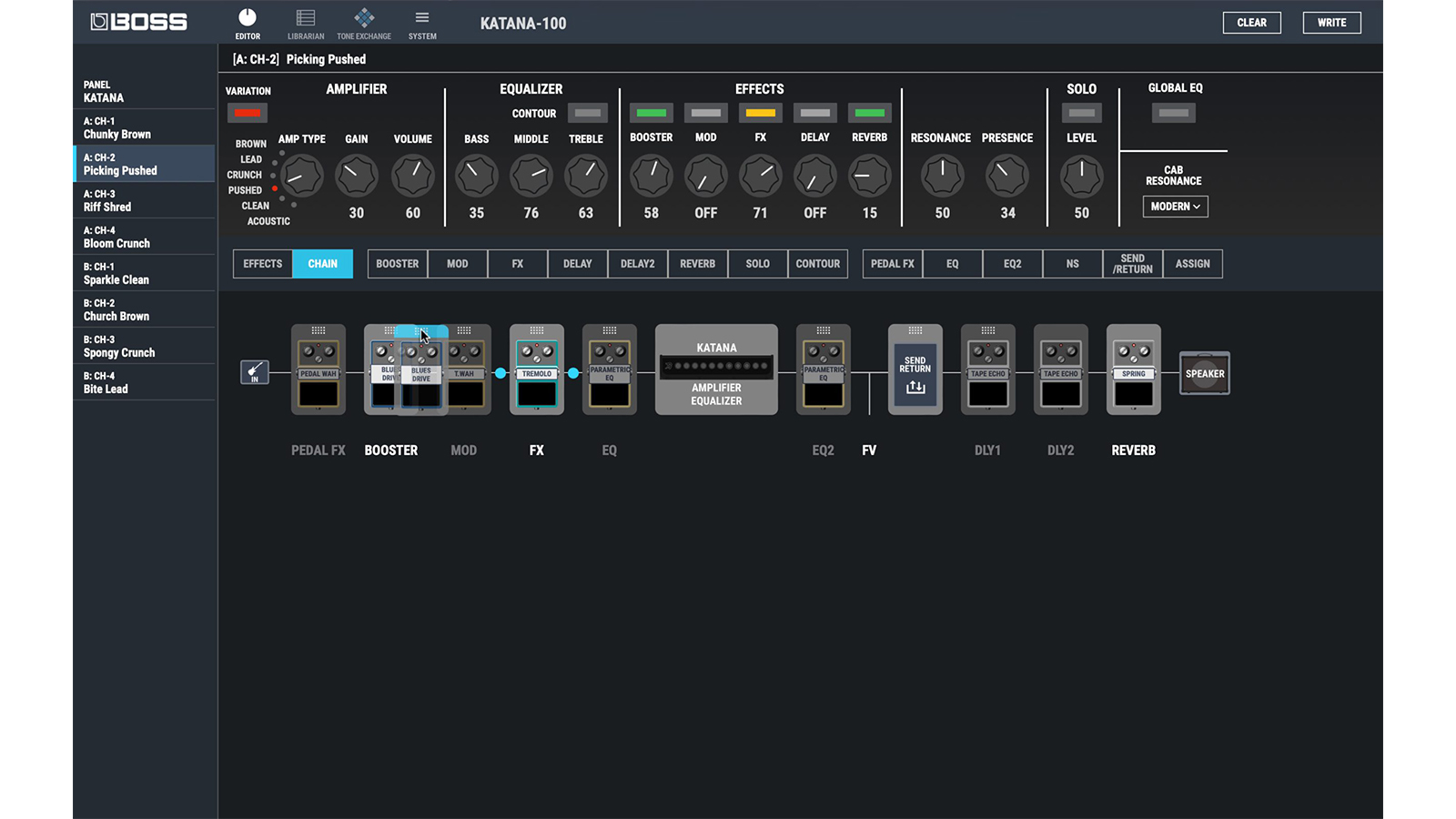
Moving on to the effects section, there isn’t a significant change compared to the Gen 2 Katana Head. Utilizing concentric knobs, all five effects can be used simultaneously, which is a big appeal. Boss has adopted an ‘if it ain’t broke, don’t fix it’ approach, but we’re not complaining. Having all these iconic Boss effects integrated into one amp is a real treat, allowing you to get pretty close to the sound in your head using the onboard controls alone.
However, it’s in the Boss Tone Studio where the effects section truly shines. There’s a vast library of effects pedals you can tweak to your heart’s content, and the desktop app offers a range of editable parameters for each effect that give modelers like the Line 6 Helix a run for their money. From the depth and rate of modulation to low-cut and high-cut filters on reverb, I had a lot of fun tweaking and getting a plethora of different tones.
One improvement to the Tone Studio that I really appreciated is the ability to creatively arrange your effects; while editing your saved channels in the chain tab, you can now simply drag and drop some effects to achieve your preferred order.
Another notable addition to the third generation Head is the ability to edit effects wirelessly from your smartphone via Bluetooth. While Boss’ Tone Studio has always been available through a wired computer connection, this wireless option removes the hassle of extra cables.
It is a bit disappointing that you need to purchase Boss’ Bluetooth adapter separately for around $50. My review unit was shipped with the adapter and I found that editing effects on my smartphone was hassle-free and seamless. Plus, it enables you to stream audio while jamming along to backing tracks or your favorite songs. Well worth the extra investment, in my opinion.
The new Solo function is a welcomed addition; when activated, it provides a boost in both volume and gain, perfect for blasting out hair-raising solos on the fly. Also, on this side of the control panel is the saveable Tone Setting channels. There are eight saveable presets in total split between Bank A or B.
Without a doubt, the effects, Solo function, and saved Tone Settings are best managed with the additional GA-FC EX foot controller. Since the Katana Head is largely designed for gigging, having the foot controller ties these features together into a genuinely gig-friendly package. Although another added extra, costing around $/£140, it allows you to switch between banks, channels, presets, and effects with your foot. Much more convenient in a live setting.
The Power Control attenuator returns, letting you dial down to just 0.5 watts for home practice and delivering that cranked amp tone without disturbing the neighbors. The other settings, Half and Max, offer even more fine-tuning to your surroundings. Max power provides approximately 30 watts through the internal speaker and a full 100 watts when used with an external cabinet.
Also carried over from the Gen 2 Katana Head is the Cab Resonance switch, offering three distinct options: Vintage for a spongy low-end, Modern for a tighter, balanced response, and Deep for an enhanced emphasis on the lower frequencies. There is certainly a noticeable difference between all three. I was genuinely impressed with the amount it colored my cabinet, with modern standing out as a personal favorite.
Final verdict
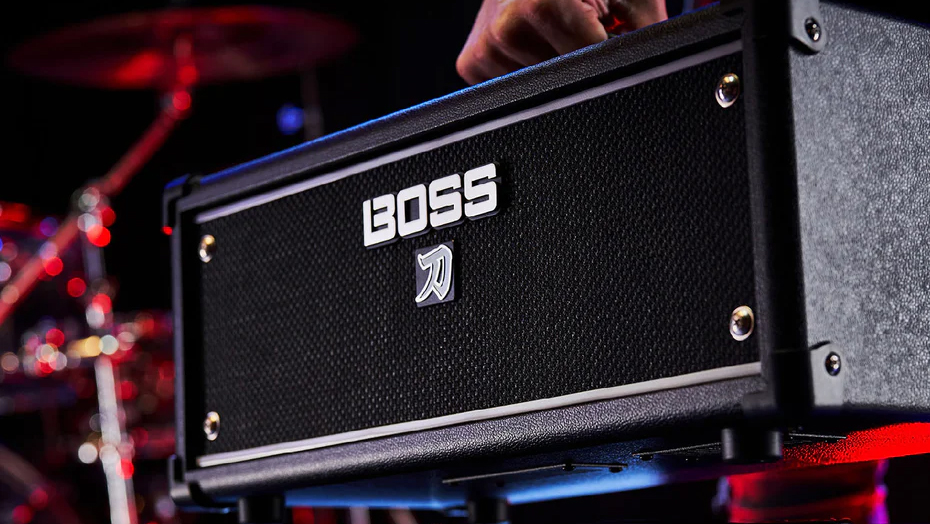
The Boss Katana Head Gen 3 is a masterclass in versatility, seamlessly bridging the gap between practice and performance. Its internal 5-inch speaker is ideal for home use, while the ability to connect to a cabinet unleashes arena-filling power. The amp offers a rich array of tones and iconic Boss effects, enhanced by the user-friendly Tone Studio, now compatible with smartphones. New features like the Solo function, Contour controls and Bloom elevate the experience, making it perfect for both recording and live gigs. For a solid-state amp it provides an incredibly dynamic, tube-like response. Overall, it’s an impressive amplifier head that can be the one-stop shop for a gigging guitarist who wants to practice with the same model at home.
Specification
- Type: Solid state
- Output: 30W (using internal speaker), 100 W (using external speaker)
- Speaker: 12cm (5 inches) x 1
- Connectivity: input jack, 1/4-inch phone type; power amp in jack, 1/4-inch phone type; line out jack, 1/4-inch phone type; send jack, 1/4-inch phone type; return jack, 1/4-inch phone type; speaker out 1/4-inch phone type (min 8 ohms); stereo phones, stereo 1/4-inch phone type; expression pedal, 1/4-inch TRS phone type; solo jack: 1/4-inch TRS phone type; aux in jack, stereo miniature phone type; USB-C; MIDI in connector; Bluetooth Audio MIDI Dual Adaptor
- Weight: 8.8kg
- Dimensions: 470 (W) x 228 (D) x 215 (H) mm
- Contact: Boss
Ross has been a music lover and guitar player since the age of 8. He has spent the five years since graduating from university working in music retail, selling guitars, amps and more. Ross is particularly interested in electric guitars, pedals and amplifiers and his current rig includes a trusty 2009 American Standard Stratocaster and Vox AC30S1 with a few Walrus Audio and Way Huge pedals in between.
“I suppose I felt that I deserved it for the amount of seriousness that I’d put into it. My head was huge!” “Clapton is God” graffiti made him a guitar legend when he was barely 20 – he says he was far from uncomfortable with the adulation at the time
“I was in a frenzy about it being trapped and burnt up. I knew I'd never be able to replace it”: After being pulled from the wreckage of a car crash, John Sykes ran back to his burning vehicle to save his beloved '76 Les Paul
“It holds its own purely as a playable guitar. It’s really cool for the traveling musician – you can bring it on a flight and it fits beneath the seat”: Why Steve Stevens put his name to a foldable guitar
